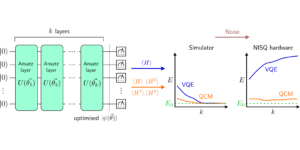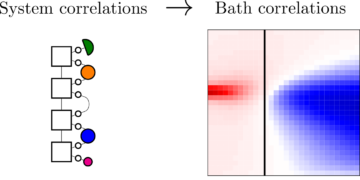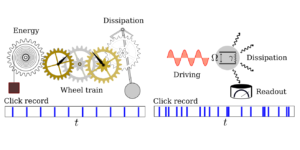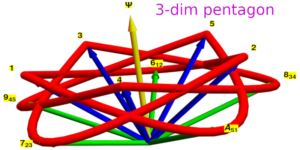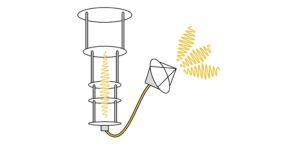1Quantum Research Center, Technology Innovation Institute (TII), Abu Dhabi, UAE
2Dahlem Center for Complex Quantum Systems, Freie Universität Berlin, Germany
3Joint Center for Quantum Information and Computer Science (QuICS), University of Maryland/NIST, USA
4Helmholtz-Zentrum Berlin für Materialien und Energie, Germany
Find this paper interesting or want to discuss? Scite or leave a comment on SciRate.
Abstract
Extracting tomographic information about quantum states is a crucial task in the quest towards devising high-precision quantum devices. Current schemes typically require measurement devices for tomography that are a priori calibrated to high precision. Ironically, the accuracy of the measurement calibration is fundamentally limited by the accuracy of state preparation, establishing a vicious cycle. Here, we prove that this cycle can be broken and the dependence on the measurement device’s calibration significantly relaxed. We show that exploiting the natural low-rank structure of quantum states of interest suffices to arrive at a highly scalable `blind’ tomography scheme with a classically efficient post-processing algorithm. We further improve the efficiency of our scheme by making use of the sparse structure of the calibrations. This is achieved by relaxing the blind quantum tomography problem to the de-mixing of a sparse sum of low-rank matrices. We prove that the proposed algorithm recovers a low-rank quantum state and the calibration provided that the measurement model exhibits a restricted isometry property. For generic measurements, we show that it requires a close-to-optimal number of measurement settings. Complementing these conceptual and mathematical insights, we numerically demonstrate that robust blind quantum tomography is possible in a practical setting inspired by an implementation of trapped ions.
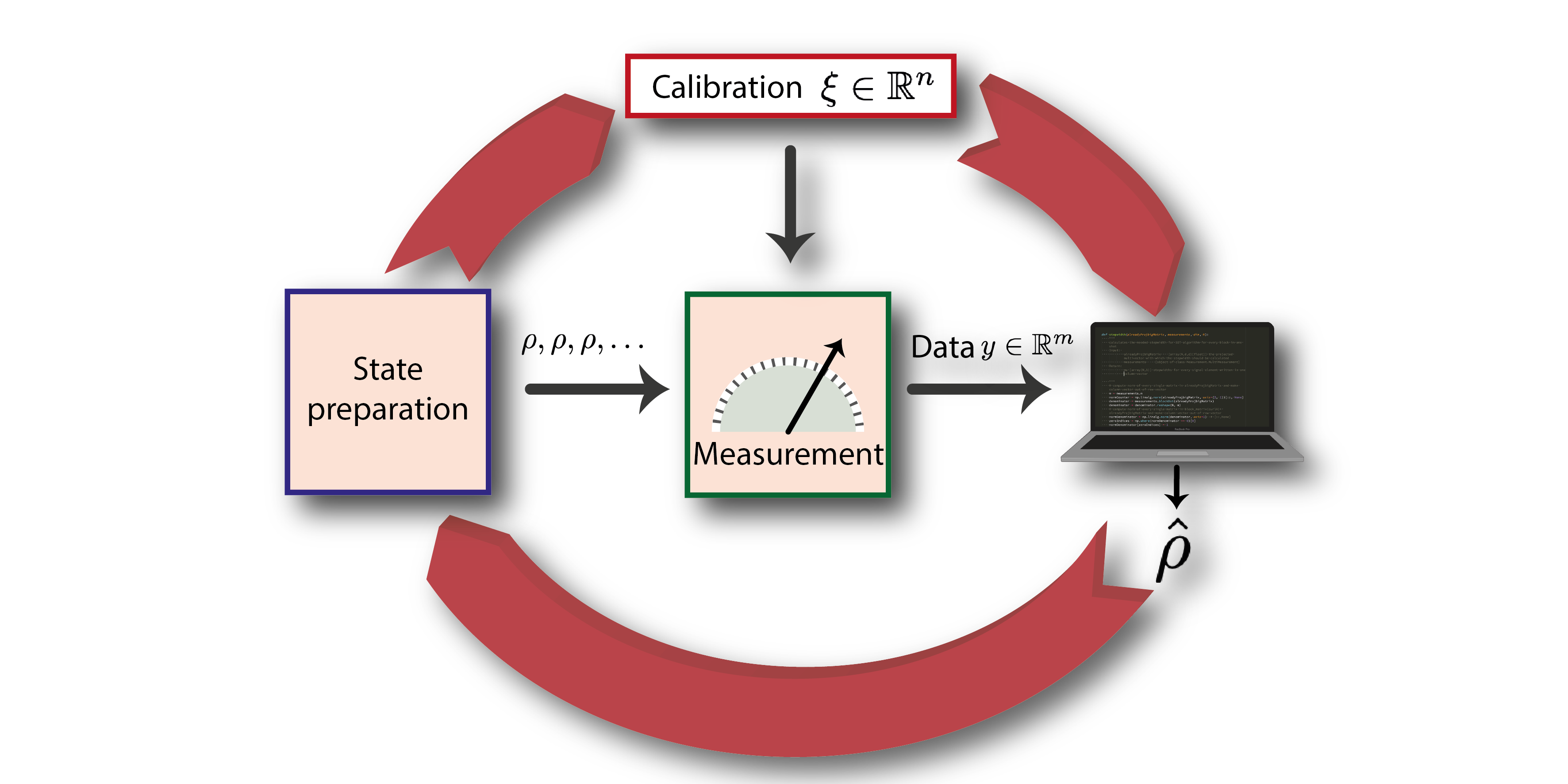
Featured image: Blind quantum state tomography breaks the vicious cycle linking imperfect state preparation and calibration of measurement devices for low-rank states.
Popular summary
In our work, we give a mathematical proof that this is possible if the quantum states are sufficiently pure. We assume that measured data depend linearly on the state and a set of calibration parameters that model small deviations from a calibration baseline. We develop an algorithm that can be efficiently run on a classical computer and prove that given the data as an input, the algorithm converges to the correct state and calibration parameters provided the measurement is suitably unstructured. The number of required measurement scales close to optimally in the degrees of freedom of the problem. Since a pure state is described by fewer parameters than an arbitrary quantum state, our structure assumption allows us to additionally estimate calibration parameters without increasing the number of measurements. Furthermore, we numerically demonstrate that our method works in a setting that is motivated by ion traps experiments. Altogether, we develop a method that we expect to be useful in practice for high-precision state tomography based on the theoretical and numerical evidence.
► BibTeX data
► References
[1] J. Preskill. “Quantum computing in the NISQ era and beyond”. Quantum 2, 79 (2018).
https://doi.org/10.22331/q-2018-08-06-79
[2] A. Acin, I. Bloch, H. Buhrman, T. Calarco, C. Eichler, J. Eisert, D. Esteve, N. Gisin, S. J. Glaser, F. Jelezko, S. Kuhr, M. Lewenstein, M. F. Riedel, P. O. Schmidt, R. Thew, A. Wallraff, I. Walmsley, and F. K. Wilhelm. “The European quantum technologies roadmap”. New J. Phys. 20, 080201 (2017). arXiv:1712.03773.
https://doi.org/10.1088/1367-2630/aad1ea
arXiv:1712.03773
[3] J. Eisert, D. Hangleiter, N. Walk, I. Roth, R. Markham, D.and Parekh, U. Chabaud, and E. Kashefi. “Quantum certification and benchmarking”. Nature Rev. Phys. 2, 382–390 (2020). arXiv:1910.06343.
https://doi.org/10.1038/s42254-020-0186-4
arXiv:1910.06343
[4] S. Boixo, S. V. Isakov, V. N. Smelyanskiy, R. Babbush, N. Ding, Z. Jiang, M. J. Bremner, J. M. Martinis, and H. Neven. “Characterizing quantum supremacy in near-term devices”. Nature Phys. 14, 595–600 (2018). arXiv:1608.00263.
https://doi.org/10.1038/s41567-018-0124-x
arXiv:1608.00263
[5] D. Hangleiter and J. Eisert. “Computational advantage of quantum random sampling” (2023). arXiv:2206.04079.
arXiv:2206.04079
[6] J. Emerson, R. Alicki, and K. Życzkowski. “Scalable noise estimation with random unitary operators”. J. Opt. B 7, S347 (2005).
https://doi.org/10.1088/1464-4266/7/10/021
[7] E. Knill, D. Leibfried, R. Reichle, J. Britton, R. B. Blakestad, J. D. Jost, C. Langer, R. Ozeri, S. Seidelin, and D. J. Wineland. “Randomized benchmarking of quantum gates”. Phys. Rev. A 77, 012307 (2008). arXiv:0707.0963.
https://doi.org/10.1103/PhysRevA.77.012307
arXiv:0707.0963
[8] E. Magesan, J. M. Gambetta, and J. Emerson. “Scalable and robust randomized benchmarking of quantum processes”. Phys. Rev. Lett. 106, 180504 (2011). arXiv:1009.3639.
https://doi.org/10.1103/PhysRevLett.106.180504
arXiv:1009.3639
[9] J. Helsen, I. Roth, E. Onorati, A.H. Werner, and J. Eisert. “General framework for randomized benchmarking”. PRX Quantum 3, 020357 (2022).
https://doi.org/10.1103/PRXQuantum.3.020357
[10] S. T. Merkel, J. M. Gambetta, J. A. Smolin, S. Poletto, A. D. Córcoles, B. R. Johnson, C. A. Ryan, and M. Steffen. “Self-consistent quantum process tomography”. Phys. Rev. A 87, 062119 (2013). arXiv:1211.0322.
https://doi.org/10.1103/PhysRevA.87.062119
arXiv:1211.0322
[11] R. Blume-Kohout, J. King Gamble, E. Nielsen, J. Mizrahi, J. D. Sterk, and P. Maunz. “Robust, self-consistent, closed-form tomography of quantum logic gates on a trapped ion qubit” (2013). arXiv:1310.4492.
arXiv:1310.4492
[12] A. M. Brańczyk, D. H. Mahler, L. A. Rozema, A. Darabi, A. M. Steinberg, and D. F. V. James. “Self-calibrating quantum state tomography”. New J. Phys. 14, 085003 (2012).
https://doi.org/10.1088/1367-2630/14/8/085003
[13] D. Gross, Y.-K. Liu, S. T. Flammia, S. Becker, and J. Eisert. “Quantum state tomography via compressed sensing”. Phys. Rev. Lett. 105, 150401 (2010).
https://doi.org/10.1103/PhysRevLett.105.150401
[14] S. T. Flammia, D. Gross, Y.-K. Liu, and J. Eisert. “Quantum tomography via compressed sensing: error bounds, sample complexity and efficient estimators”. New J. Phys. 14, 095022 (2012). arXiv:1205.2300.
https://doi.org/10.1088/1367-2630/14/9/095022
arXiv:1205.2300
[15] A. Kalev, R. L. Kosut, and I. H. Deutsch. “Quantum tomography protocols with positivity are compressed sensing protocols”. npj Quant. Inf. 1, 15018 (2015). arXiv:1502.00536.
https://doi.org/10.1038/npjqi.2015.18
arXiv:1502.00536
[16] C. A. Riofrio, D. Gross, S. T. Flammia, T. Monz, D. Nigg, R. Blatt, and J. Eisert. “Experimental quantum compressed sensing for a seven-qubit system”. Nature Comm. 8, 15305 (2017).
https://doi.org/10.1038/ncomms15305
[17] A. Steffens, C. A. Riofrio, W. McCutcheon, I. Roth, B. A. Bell, A. McMillan, M. S. Tame, J. G. Rarity, and J. Eisert. “Experimentally exploring compressed sensing quantum tomography”. Quant. Sc. Tech. 2, 025005 (2017).
https://doi.org/10.1088/2058-9565/aa6ae2
[18] R. G. Baraniuk, V. Cevher, M. F. Duarte, and C. Hegde. “Model-based compressive sensing”. IEEE Trans. Inf. Th. 56, 1982–2001 (2010).
https://doi.org/10.1109/TIT.2010.2040894
[19] S. Foucart and H. Rauhut. “A mathematical introduction to compressive sensing”. Springer. Berlin (2013).
https://doi.org/10.1007/978-0-8176-4948-7
[20] T. Blumensath and M. E. Davies. “Iterative thresholding for sparse approximations”. J. Four. An. App. 14, 629–654 (2008).
https://doi.org/10.1007/s00041-008-9035-z
[21] T. Strohmer and K. Wei. “Painless breakups-efficient demixing of low rank matrices”. J. Four. Ana. App. 25, 1–31 (2019).
https://doi.org/10.1007/s00041-017-9564-4
[22] I. Roth, M. Kliesch, A. Flinth, G. Wunder, and J. Eisert. “Reliable recovery of hierarchically sparse signals for Gaussian and Kronecker product measurements”. IEEE Trans. Sig. Proc. 68, 4002–4016 (2020). arXiv:1612.07806.
https://doi.org/10.1109/TSP.2020.3003453
arXiv:1612.07806
[23] M. Pawłowski and N. Brunner. “Semi-device-independent security of one-way quantum key distribution”. Phys. Rev. A 84, 010302 (2011).
https://doi.org/10.1103/PhysRevA.84.010302
[24] Y.-C. Liang, T. Vértesi, and N. Brunner. “Semi-device-independent bounds on entanglement”. Phys. Rev. A 83, 022108 (2011).
https://doi.org/10.1103/PhysRevA.83.022108
[25] H.-W. Li, Z.-Q. Yin, Y.-C. Wu, X.-B. Zou, S. Wang, W. Chen, G.-C. Guo, and Z.-F. Han. “Semi-device-independent random-number expansion without entanglement”. Phys. Rev. A 84, 034301 (2011).
https://doi.org/10.1103/PhysRevA.84.034301
[26] H.-W. Li, M. Pawłowski, Z.-Q. Yin, G.-C. Guo, and Z.-F. Han. “Semi-device-independent randomness certification using $nrightarrow1$ quantum random access codes”. Phys. Rev. A 85, 052308 (2012).
https://doi.org/10.1103/PhysRevA.85.052308
[27] R. Gallego, N. Brunner, C. Hadley, and A. Acin. “Device-independent tests of classical and quantum dimensions”. Phys. Rev. Lett. 105, 230501 (2010).
https://doi.org/10.1103/PhysRevLett.105.230501
[28] D. Mogilevtsev. “Calibration of single-photon detectors using quantum statistics”. Phys. Rev. A 82, 021807 (2010).
https://doi.org/10.1103/PhysRevA.82.021807
[29] D. Mogilevtsev, J. Řeháček, and Z. Hradil. “Relative tomography of an unknown quantum state”. Phys. Rev. A 79, 020101 (2009).
https://doi.org/10.1103/PhysRevA.79.020101
[30] D. Mogilevtsev, J. Řeháček, and Z. Hradil. “Self-calibration for self-consistent tomography”. New J. Phys. 14, 095001 (2012).
https://doi.org/10.1088/1367-2630/14/9/095001
[31] J. Y. Sim, J. Shang, H. K. Ng, and B.-G. Englert. “Proper error bars for self-calibrating quantum tomography”. Phys. Rev. A 100, 022333 (2019).
https://doi.org/10.1103/PhysRevA.100.022333
[32] C. Stark. “Simultaneous estimation of dimension, states and measurements: Computation of representative density matrices and POVMs” (2012). arXiv:1210.1105.
arXiv:1210.1105
[33] C. Stark. “Self-consistent tomography of the state-measurement Gram matrix”. Phys. Rev. A 89, 052109 (2014). arXiv:1209.5737.
https://doi.org/10.1103/PhysRevA.89.052109
arXiv:1209.5737
[34] J. Řeháček, D. Mogilevtsev, and Z. Hradil. “Operational tomography: Fitting of data patterns”. Phys. Rev. Lett. 105, 010402 (2010).
https://doi.org/10.1103/PhysRevLett.105.010402
[35] L. Motka, B. Stoklasa, J. Rehacek, Z. Hradil, V. Karasek, D. Mogilevtsev, G. Harder, C. Silberhorn, and L. L. Sánchez-Soto. “Efficient algorithm for optimizing data-pattern tomography”. Phys. Rev. A 89, 054102 (2014).
https://doi.org/10.1103/PhysRevA.89.054102
[36] C. Ferrie. “Quantum model averaging”. New J. Phys. 16, 093035 (2014).
https://doi.org/10.1088/1367-2630/16/9/093035
[37] D. Greenbaum. “Introduction to quantum gate set tomography” (2015). arXiv:1509.02921.
arXiv:1509.02921
[38] R. Blume-Kohout, J. K. Gamble, E. Nielsen, K. Rudinger, J. Mizrahi, K. Fortier, and P. Maunz. “Demonstration of qubit operations below a rigorous fault tolerance threshold with gate set tomography”. Nature Comm. 8, 14485 (2017). arXiv:1605.07674.
https://doi.org/10.1038/ncomms14485
arXiv:1605.07674
[39] P. Cerfontaine, R. Otten, and H. Bluhm. “Self-consistent calibration of quantum-gate sets”. Phys. Rev. Appl. 13, 044071 (2020). arXiv:1906.00950.
https://doi.org/10.1103/PhysRevApplied.13.044071
arXiv:1906.00950
[40] R. Brieger, I. Roth, and M. Kliesch. “Compressive gate set tomography”. PRX Quantum 4, 010325 (2023).
https://doi.org/10.1103/PRXQuantum.4.010325
[41] D. Gross. “Recovering low-rank matrices from few coefficients in any basis”. IEEE Trans. Inf. Th. 57, 1548–1566 (2011). arXiv:0910.1879.
https://doi.org/10.1109/TIT.2011.2104999
arXiv:0910.1879
[42] Y.-K. Liu. “Universal low-rank matrix recovery from Pauli measurements”. Adv. Neural Inf. Process. Syst. 24, 1638–1646 (2011). arXiv:1103.2816.
https://doi.org/10.48550/arXiv.1103.2816
arXiv:1103.2816
[43] R. Kueng. “Low rank matrix recovery from few orthonormal basis measurements”. In Sampling Theory and Applications (SampTA), 2015 International Conference on. Pages 402–406. (2015).
https://doi.org/10.1109/SAMPTA.2015.7148921
[44] M. Kabanava, R. Kueng, H. Rauhut, and U. Terstiege. “Stable low-rank matrix recovery via null space properties”. Inf. Inf. 5, 405–441 (2016).
https://doi.org/10.1093/imaiai/iaw014
[45] A. Shabani, R. L. Kosut, M. Mohseni, H. Rabitz, M. A. Broome, M. P. Almeida, A. Fedrizzi, and A. G. White. “Efficient measurement of quantum dynamics via compressive sensing”. Phys. Rev. Lett. 106, 100401 (2011).
https://doi.org/10.1103/PhysRevLett.106.100401
[46] S. Kimmel and Y. K. Liu. “Phase retrieval using unitary 2-designs”. In 2017 International Conference on Sampling Theory and Applications (SampTA). Pages 345–349. (2017). arXiv:1510.08887.
https://doi.org/10.1109/SAMPTA.2017.8024414
arXiv:1510.08887
[47] I. Roth, R. Kueng, S. Kimmel, Y.-K. Liu, D. Gross, J. Eisert, and M. Kliesch. “Recovering quantum gates from few average gate fidelities”. Phys. Rev. Lett. 121, 170502 (2018). arXiv:1803.00572.
https://doi.org/10.1103/PhysRevLett.121.170502
arXiv:1803.00572
[48] G. Wunder, H. Boche, T. Strohmer, and P. Jung. “Sparse signal processing concepts for efficient 5G system design”. IEEE Acc. 3, 195–208 (2015).
https://doi.org/10.1109/ACCESS.2015.2407194
[49] I. Roth, M. Kliesch, G. Wunder, and J. Eisert. “Reliable recovery of hierarchically sparse signals”. In Proceedings of the third “international traveling workshop on interactions between sparse models and technology” (iTWIST’16). (2016). arXiv:1609.04167.
arXiv:1609.04167
[50] A. Ahmed, B. Recht, and J. Romberg. “Blind deconvolution using convex programming”. IEEE Trans. Inf. Th. 60, 1711–1732 (2014).
https://doi.org/10.1109/TIT.2013.2294644
[51] S. Oymak, A. Jalali, M. Fazel, Y. C. Eldar, and B. Hassibi. “Simultaneously structured models with application to sparse and low-rank matrices”. IEEE Trans. Inf. Th. 61, 2886–2908 (2015).
https://doi.org/10.1109/TIT.2015.2401574
[52] D. Needell and J. A. Tropp. “CoSaMP: Iterative signal recovery from incomplete and inaccurate samples”. Appl. Comp. Harm. An. 26, 301 (2008).
https://doi.org/10.1145/1859204.1859229
[53] S. Foucart. “Hard thresholding pursuit: An algorithm for compressive sensing”. SIAM J. Num. An. 49, 2543–2563 (2011).
https://doi.org/10.1137/100806278
[54] M. Magdon-Ismail. “NP-hardness and inapproximability of sparse PCA”. Inf. Proc. Lett. 126, 35–38 (2017).
https://doi.org/10.1016/j.ipl.2017.05.008
[55] Q. Berthet and P. Rigollet. “Complexity theoretic lower bounds for sparse principal component detection”. In Conference on Learning Theory. Pages 1046–1066. (2013). url: http://proceedings.mlr.press/v30/Berthet13.html.
http://proceedings.mlr.press/v30/Berthet13.html
[56] Q. Berthet and P. Rigollet. “Optimal detection of sparse principal components in high dimension”. Ann. Statist. 41, 1780–1815 (2013).
https://doi.org/10.1214/13-AOS1127
[57] M. Brennan and G. Bresler. “Optimal average-case reductions to sparse PCA: From weak assumptions to strong hardness”. In 32nd Annual Conference on Learning Theory. Volume 99 of Proceedings of Machine Learning Research. (2019). arXiv:1902.07380.
arXiv:1902.07380
[58] S. O. Chan, D. Papailliopoulos, and A. Rubinstein. “On the approximability of sparse PCA”. In PMLR. Volume 49, pages 623–646. (2016). arXiv:1507.05950.
arXiv:1507.05950
[59] G. Wunder, I. Roth, R. Fritschek, B. Groß, and J. Eisert. “Secure massive IoT using hierarchical fast blind deconvolution”. In 2018 IEEE Wireless Communications and Networking Conference Workshops, WCNC 2018 Workshops, Barcelona, Spain, April 15-18, 2018. Pages 119–124. (2018). arXiv:1801.09628.
https://doi.org/10.1109/WCNCW.2018.8369038
arXiv:1801.09628
[60] S. Foucart, R. Gribonval, L. Jacques, and H. Rauhut. “Jointly low-rank and bisparse recovery: Questions and partial answers” (2019). arXiv:1902.04731.
arXiv:1902.04731
[61] P. Sprechmann, I. Ramirez, G. Sapiro, and Y. Eldar. “Collaborative hierarchical sparse modeling”. In 2010 44th Annual Conference on Information Sciences and Systems (CISS). Pages 1–6. (2010).
https://doi.org/10.1109/CISS.2010.5464845
[62] J. Friedman, T. Hastie, and R. Tibshirani. “A note on the group Lasso and a sparse group Lasso” (2010). arXiv:1001.0736.
arXiv:1001.0736
[63] P. Sprechmann, I. Ramirez, G. Sapiro, and Y. C. Eldar. “C-HiLasso: A collaborative hierarchical sparse modeling framework”. IEEE Trans. Sig. Proc. 59, 4183–4198 (2011).
https://doi.org/10.1109/TSP.2011.2157912
[64] N. Simon, J. Friedman, T. Hastie, and R. Tibshirani. “A sparse-group Lasso”. J. Comp. Graph. Stat. 22, 231–245 (2013).
https://doi.org/10.1080/10618600.2012.681250
[65] I. Roth, A. Flinth, R. Kueng, J. Eisert, and G. Wunder. “Hierarchical restricted isometry property for Kronecker product measurements”. In 2018 56th Annual Allerton Conference on Communication, Control, and Computing (Allerton). Pages 632–638. (2018).
https://doi.org/10.1109/ALLERTON.2018.8635829
[66] A. Flinth, B. Groß, I. Roth, J. Eisert, and G. Wunder. “Hierarchical isometry properties of hierarchical measurements”. Appl. Comp. Harm. An. 58, 27–49 (2022). arXiv:2005.10379.
https://doi.org/10.1016/j.acha.2021.12.006
arXiv:2005.10379
[67] G. Wunder, I. Roth, R. Fritschek, and J. Eisert. “HiHTP: A custom-tailored hierarchical sparse detector for massive MTC”. In 2017 51st Asilomar Conference on Signals, Systems, and Computers. Pages 1929–1934. (2017).
https://doi.org/10.1109/ACSSC.2017.8335701
[68] G. Wunder, I. Roth, R. Fritschek, and J. Eisert. “Performance of hierarchical sparse detectors for massive MTC” (2018). arXiv:1806.02754.
arXiv:1806.02754
[69] G. Wunder, I. Roth, M. Barzegar, A. Flinth, S. Haghighatshoar, G. Caire, and G. Kutyniok. “Hierarchical sparse channel estimation for massive mimo”. In WSA 2018; 22nd International ITG Workshop on Smart Antennas. Pages 1–8. VDE (2018).
[70] G. Wunder, S. Stefanatos, A. Flinth, I. Roth, and G. Caire. “Low-overhead hierarchically-sparse channel estimation for multiuser wideband massive MIMO”. IEEE Trans. Wire. Comm. 18, 2186–2199 (2019).
https://doi.org/10.1109/TWC.2019.2900637
[71] G. H. Golub and C. F. van Loan. “Matrix computations”. The Johns Hopkins University Press. Baltimore (1989).
https://doi.org/10.2307/3619868
[72] N. Halko, P.-G. Martinsson, and J. A. Tropp. “Finding structure with randomness: Probabilistic algorithms for constructing approximate matrix decompositions”. SIAM Rev. 53, 217–288 (2011).
https://doi.org/10.1137/090771806
[73] C. A. R. Hoare. “Algorithm 65: Find”. Commun. ACM 4, 321–322 (1961).
https://doi.org/10.1145/366622.366647
[74] K. Wei, J.-F. Cai, T. F. Chan, and S. Leung. “Guarantees of Riemannian optimization for low rank matrix recovery”. SIAM J. Mat. An. App. 37, 1198–1222 (2016).
https://doi.org/10.1137/15M1050525
[75] P.-A. Absil, R. Mahony, and R. Sepulchre. “Optimization algorithms on matrix manifolds”. Princeton University Press. (2009).
https://doi.org/10.1515/9781400830244
[76] B. Vandereycken. “Low-rank matrix completion by Riemannian optimization”. SIAM J. Opt. 23, 1214–1236 (2013).
https://doi.org/10.1137/110845768
[77] T. Blumensath and M. E. Davies. “Sampling theorems for signals from the union of finite-dimensional linear subspaces”. IEEE Trans. Inf. Theory 55, 1872–1882 (2009).
https://doi.org/10.1109/TIT.2009.2013003
[78] A. S. Bandeira, E. Dobriban, D. G. Mixon, and W. F. Sawin. “Certifying the restricted isometry property is hard”. IEEE Trans. Inf. Th. 59, 3448–3450 (2013).
https://doi.org/10.1109/TIT.2013.2248414
[79] J. Wilkens, D. Hangleiter, and I. Roth (2020). Gitlab repository at https://gitlab.com/wilkensJ/blind-quantum-tomography.
https://gitlab.com/wilkensJ/blind-quantum-tomography
[80] R. Bhatia. “Matrix analysis”. Graduate texts in mathematics. Springer. New York (1997).
https://doi.org/10.1007/978-1-4612-0653-8
[81] E. J. Candes and Y. Plan. “Tight oracle inequalities for low-rank matrix recovery from a minimal optnumber of noisy random measurements”. IEEE Trans. Inf. Th. 57, 2342–2359 (2011).
https://doi.org/10.1109/TIT.2011.2111771
Cited by
[1] Raphael Brieger, Ingo Roth, and Martin Kliesch, “Compressive Gate Set Tomography”, PRX Quantum 4 1, 010325 (2023).
[2] Dominik Hangleiter, Ingo Roth, Jens Eisert, and Pedram Roushan, “Precise Hamiltonian identification of a superconducting quantum processor”, arXiv:2108.08319, (2021).
[3] Fernando G. S. L. Brandão, Richard Kueng, and Daniel Stilck França, “Fast and robust quantum state tomography from few basis measurements”, arXiv:2009.08216, (2020).
[4] Shin-Liang Chen and Jens Eisert, “(Semi-)device independently characterizing quantum temporal correlations”, arXiv:2305.19548, (2023).
[5] Jens Eisert, Axel Flinth, Benedikt Groß, Ingo Roth, and Gerhard Wunder, “Hierarchical compressed sensing”, arXiv:2104.02721, (2021).
[6] Axel Flinth, Benedikt Groß, Ingo Roth, Jens Eisert, and Gerhard Wunder, “Hierarchical Isometry Properties of Hierarchical Measurements”, arXiv:2005.10379, (2020).
[7] Burhan Gulbahar, “K-sparse Pure State Tomography with Phase Estimation”, arXiv:2111.04359, (2021).
[8] Axel Flinth, Ingo Roth, Benedikt Groß, Jens Eisert, and Gerhard Wunder, “Guaranteed blind deconvolution and demixing via hierarchically sparse reconstruction”, arXiv:2111.03486, (2021).
The above citations are from SAO/NASA ADS (last updated successfully 2023-07-13 10:06:18). The list may be incomplete as not all publishers provide suitable and complete citation data.
On Crossref’s cited-by service no data on citing works was found (last attempt 2023-07-13 10:06:16).
This Paper is published in Quantum under the Creative Commons Attribution 4.0 International (CC BY 4.0) license. Copyright remains with the original copyright holders such as the authors or their institutions.
- SEO Powered Content & PR Distribution. Get Amplified Today.
- PlatoData.Network Vertical Generative Ai. Empower Yourself. Access Here.
- PlatoAiStream. Web3 Intelligence. Knowledge Amplified. Access Here.
- PlatoESG. Automotive / EVs, Carbon, CleanTech, Energy, Environment, Solar, Waste Management. Access Here.
- BlockOffsets. Modernizing Environmental Offset Ownership. Access Here.
- Source: https://quantum-journal.org/papers/q-2023-07-11-1053/
- :is
- :not
- ][p
- 1
- 10
- 100
- 11
- 12
- 13
- 14
- 15%
- 16
- 17
- 19
- 20
- 2005
- 2008
- 2011
- 2012
- 2013
- 2014
- 2015
- 2016
- 2017
- 2018
- 2019
- 2020
- 2021
- 2022
- 2023
- 22
- 23
- 24
- 25
- 26%
- 27
- 28
- 30
- 31
- 32
- 33
- 36
- 39
- 40
- 49
- 50
- 51
- 5G
- 60
- 66
- 67
- 7
- 70
- 72
- 75
- 77
- 8
- 80
- 84
- 87
- 9
- a
- Able
- About
- About Quantum
- above
- ABSTRACT
- abu dhabi
- access
- accuracy
- accurate
- accurately
- achieved
- ACM
- Additionally
- ADvantage
- affiliations
- algorithm
- algorithms
- All
- allows
- altogether
- an
- Ana
- analysis
- and
- annual
- answers
- any
- app
- Application
- applications
- approximate
- April
- ARE
- AS
- assume
- assumption
- At
- author
- authors
- average
- averaging
- baltimore
- barcelona
- bars
- based
- Baseline
- basic
- basis
- BE
- Bell
- below
- benchmarking
- Berlin
- between
- Beyond
- Break
- breaks
- Broken
- by
- CAN
- Center
- Certification
- chan
- Channel
- chen
- Close
- codes
- collaborative
- comm
- comment
- Commons
- Communication
- Communications
- COMP
- complete
- completion
- complex
- complexity
- component
- components
- computation
- computations
- computer
- computer science
- computers
- computing
- concepts
- conceptual
- Conference
- constructing
- control
- Convex
- copyright
- correct
- crucial
- Current
- cycle
- Daniel
- data
- demonstrate
- dependence
- described
- Design
- Detection
- Determine
- determining
- develop
- device
- Devices
- Dhabi
- Dimension
- dimensions
- discuss
- distribution
- dynamics
- e
- efficiency
- efficient
- efficiently
- employed
- entanglement
- Era
- error
- establishing
- estimate
- European
- evidence
- exhibits
- expansion
- expect
- experiments
- exploiting
- Exploring
- FAST
- few
- fewer
- Find
- First
- fitting
- flexible
- For
- found
- four
- Framework
- Freedom
- from
- functioning
- fundamentally
- further
- Furthermore
- Gamble
- Gates
- General
- Give
- given
- graduate
- Gram
- graph
- gross
- Group
- guaranteed
- Hard
- harder
- harm
- harvard
- here
- High
- highly
- holders
- HTML
- http
- HTTPS
- i
- Identification
- IEEE
- if
- image
- implementation
- improve
- in
- inaccurate
- increasing
- independently
- inequalities
- information
- Innovation
- input
- insights
- inspired
- Institute
- institutions
- interactions
- interest
- interesting
- International
- Introduction
- iot
- Ironically
- IT
- james
- JavaScript
- Johns Hopkins University
- Johnson
- journal
- Key
- King
- Last
- learning
- Leave
- Li
- License
- Limited
- linking
- List
- loan
- logic
- Low
- lower
- machine
- machine learning
- Making
- Martin
- massive
- mathematical
- mathematics
- Matrix
- max-width
- May..
- measurement
- measurements
- method
- minimal
- model
- modeling
- models
- Month
- motivated
- Natural
- Nature
- needs
- networking
- New
- New York
- no
- Noise
- number
- of
- on
- ONE
- open
- Operations
- operators
- optimization
- optimizing
- or
- oracle
- original
- our
- out
- pages
- Paper
- parameters
- particular
- patterns
- phase
- Place
- plan
- plato
- Plato Data Intelligence
- PlatoData
- Positivity
- possible
- Practical
- practice
- precise
- precisely
- Precision
- preparation
- press
- Principal
- Problem
- PROC
- Proceedings
- process
- processes
- processing
- Processor
- Product
- Programming
- proof
- properties
- property
- proposed
- protocols
- Prove
- provide
- provided
- published
- publisher
- publishers
- pursuit
- Quant
- Quantum
- quantum computers
- quantum gate
- quantum information
- Quantum Supremacy
- quantum systems
- Qubit
- quest
- Questions
- random
- Randomized
- randomness
- rank
- rarity
- Recovers
- recovery
- references
- remains
- repository
- representative
- require
- required
- requires
- research
- restricted
- Richard
- rigorous
- roadmap
- robust
- Run
- Ryan
- s
- SC
- scalable
- scales
- scheme
- schemes
- Science
- SCIENCES
- security
- set
- Sets
- setting
- settings
- show
- siam
- Signal
- signals
- significantly
- SIM
- Simon
- simultaneously
- since
- small
- smart
- Space
- Spain
- stark
- State
- States
- statistics
- strong
- structure
- structured
- Successfully
- such
- suitable
- superconducting
- system
- Systems
- Task
- tech
- Technologies
- Technology
- Technology Innovation
- test
- tests
- than
- that
- The
- The State
- their
- Them
- theoretical
- theory
- These
- Third
- this
- threshold
- Title
- to
- tolerance
- tools
- towards
- traps
- Traveling
- TURN
- typically
- under
- union
- university
- unknown
- updated
- URL
- us
- use
- using
- via
- volume
- W
- want
- was
- Way..
- we
- white
- Wire
- wireless
- with
- without
- Work
- works
- workshop
- Workshops
- wu
- X
- year
- york
- zephyrnet



